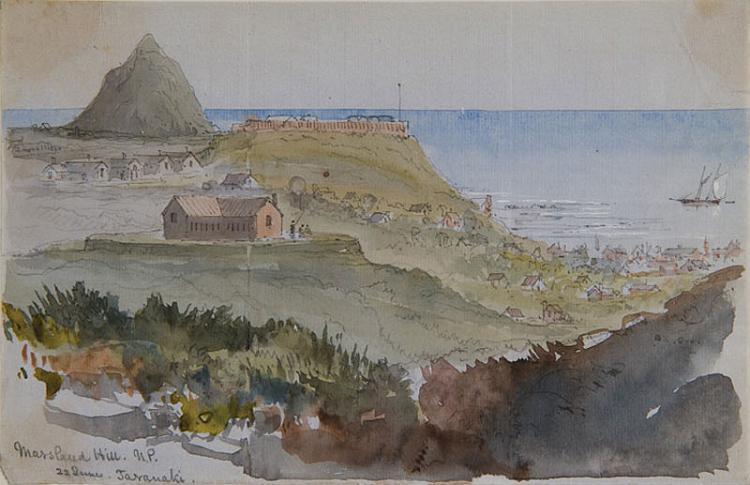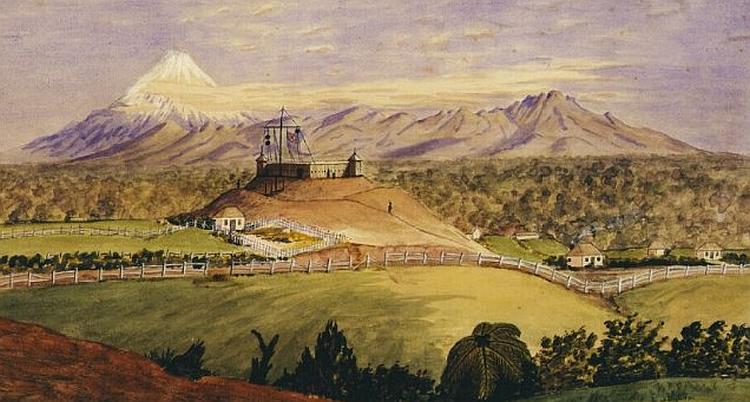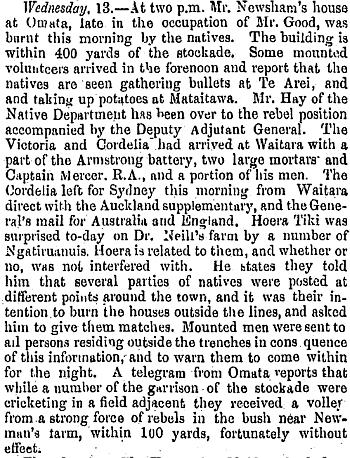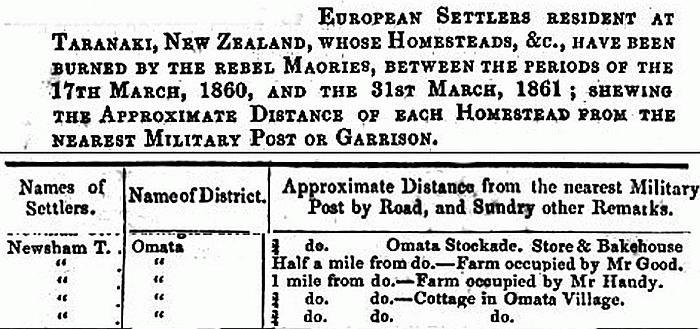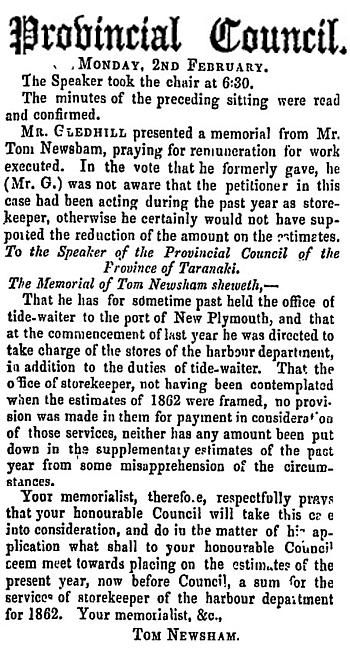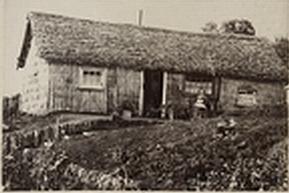|
Hidden Slide Menu on Left Below, Newsham Page Index THOMAS NEWSHAM was born 24
Dec 1821 in Wisbech, Cambridge County and baptised in 1830,
at Dr Williams Library; and left
England aged 21 years and died on 7th Feb 1874 Omata, Taranaki.
His mother was Susannah nee Jecks. The uncertainty in England
and his father Joseph's death in June
1842 became the catalyst in his decision to emigrate a few months
later to New Zealand to make a new life. He
boarded the ship "Thomas Sparkes" at London along with his
cousins, the Hursthouses. After an eventful
voyage the ship called first at Nelson, then arrived at
Wellington on March 11 1843 where it discharged
it's passengers and freight before sailing on to
Valparaiso.
It is unsubstantiated but descendants
believe Thomas and cousin Charles Hursthouse walked
overland to New Plymouth taking the opportunity to view first hand their
new country - their walk was duplicated in January
1850 by next family
arrivals, George Curtis and John Stephenson Smith.
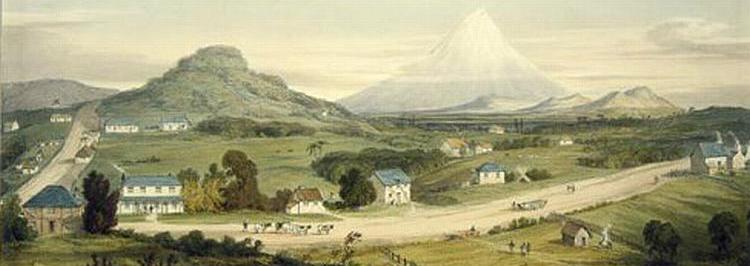 1843: In May the census included Thomas
Newsham - this gives us a very accurate insight of New
Plymouth just a few months after his arrival. The total white
population is 1090 with 690 living in the New Plymouth township
and 400 settlers in the surrounding country (in total = 616 males and
474 females - males under 21 formed half the population.) Social
class distinction records "upper class" as being 28 capitalists
cultivating their own land, 6 leasing land, 215 letting land to farmers, 3
lawyers, 3 medical practitioners, 2 clergymen( both were Dissenters yet
there were 401 C of E and
nine Catholics) 13 Government or NZ Company
employees (Thomas was one as employed in the police) 2 schoolmasters and
28 surveyors . In all, 117, and 2 schools (one for the
"wealthier class" attended by 3 pupils and the other, for the poorer folks
children attended by 25; 250 acres of land had been cleared and under
cultivation and those settlers had 102 grazing cattle, 849 sheep, 332
swine, 1063 head of poultry 24 miles of road had been constructed and
32,0031 acres had been surveyed - a considerable achievement in just
two years!
In 1844 Wakefield wrote (Ref. "Adventure in
NZ") "The approach to New Plymouth was through plains almost entirely
covered with fern, some as high as 10 ft, then through scattered
groves of timber and gentle undulations into valleys and watercourses
crossed by several wooden bridges until at last, the line of a road
through fern. We passed three or four neat houses with fields
indicating a European settlement and a rough suspension bridge being
constructed with chains supported on the round trunks of four large
tress; then "smiling gardens, neatly hedged and ditched; a forge, a row of
labourers cottages and some cob houses in various stages of
progress."
 Thomas was employed with the police - the first
New Plymouth jail was built in of wood and was replaced by a stone
jail in 1842 in James Lane, off Devon Street. In 1846 McLean took over
as police Inspector and he established a small policing unit and had
Maori constables of sufficient tribal standing valued for their
specialist knowledge and ability to mediate between the
races.
15 Oct 1845: Mr Wickstead sold a suburban section
to Mr Newsham and on 10th Sep 1846 Thomas
married MARY LOUISA
LETHBRIDGE in Wesleyan Chapel, New Plymouth, the daughter of RICHARD
LETHBRIDGE and LOUISA YATES - the family arrived 7th Nov 1841 on the "Oriental.
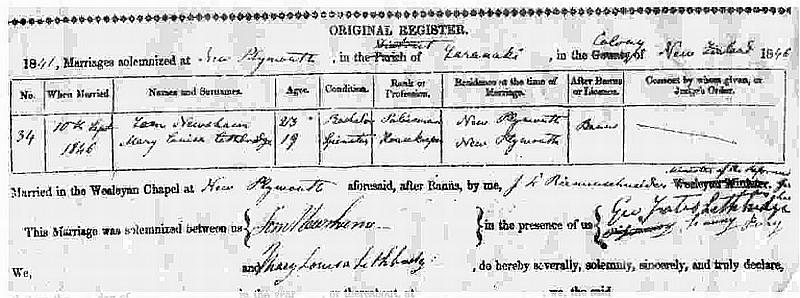 Mary was born in Ugborough, Devon where she was baptised on 14th Sept 1828.
In 1847 the native owners of the Omata
district offered expansion to settlers south of the Sugar Loaves by the
possibility of opening up 2000 acres of open land so after much
investigation, the purchase from the Taranaki tribe was made with
final payment in Sept 1849. It was opened for purchase in 1848,
among purchasers was Thomas Newsham. Later, a further Crown grant
issued by Governor Grey in Apr. 1850, was added to this area - 12,000
acres plus a 4000 acre "Tataramaka Block" - this enabled
settlers to obtain firm title to their holdings.
The main community sprung up around the flat
lowland area and at its centre eventually was a school, a bakehouse, a
brewery , an inn and a general store. A wooden church was built by
Methodist preacher Rev Rbt Ward and erected on land given by Mr
Wicksted in the heart of the village and the Anglicans built theirs
at the top end of the Waireka Road.

On Oct 16 1848, the shock of an Earthquake was felt at 2 o'clock by most
of the settlers in the district... "A very strong South East wind had set
in - it increased with much violence until on the 16th at 2am it was
followed by a shock of an Earthquake, the strongest that has been felt and
longer in its duration than any previously remembered by the European
population in the Town of New Plymouth. The principal stores in the place
were completely levelled to the ground, the large Methodist Chapel
which was opened for worship in Sept 1843 and had been capable of seating
100 and also many houses. The visitation lasted for 8 days." (Source: 19th
Century Earthquakes) [Diary entry of 4 Nov: "The Schooner 'Carbon' arrived
this afternoon from Wellington bringing information of the dreadful
effects of the Earthquake at that place on the 16th")
Omata settlers immediately after taking
possession, started clearing their land and constructing their first
shelter, usually a basic slab hut and by 1859, ten years on, it was
reported "There is no part of New Plymouth in which cultivation has been
carried on so thoroughly in the first stages as in the Omata
district and the appearance of an active and industrious population
is very cheering."(Sketch below "Building a whorry" (whare) by
William Strutt.)
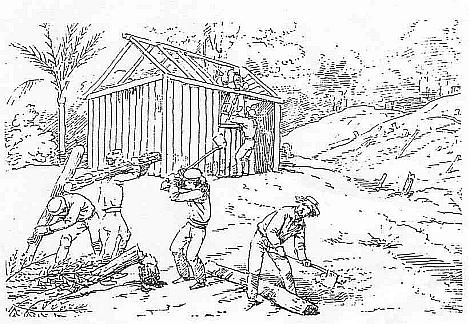 Beyond the Wawakaiho there was wilderness except for
Davy's, Smarts and Nairn's farms. The only draughthorse in the settlement
was Lightfoot, the property of William Richards however Dalby's bullock
Redmond would suffer himself to be harnessed to a cart with shafts and
assist in performing a little cartage when required.
1850 was a wet year but
all were busy clearing bush and cropping with wheat. Thomas continued to
be employed as a policeman and was considered
an efficient officer when he was living in town, but now
he was no longer visable, he incurred numerous complaints
that being stationed at Omata, the Government were now paying him for
attending to his private affairs and he "did little policing except
to walk to the Barracks in town weekly on a Saturday for orders and
back again." Halse asked Thomas in June 1850 if he had any
intention of leaving the force. His answer was recorded "that he had
replied with a smile that he was quite happy with the present
arrangement!" In October thefull pay of one
constable became divided by the employment of the Maori officer
Hakopa and we find in Sept 1851 Thomas refusing
(unless he was put back on full pay) to go to Whanganui with a dispatch
for the Governor-in-chief - his name had been put forward as no one else
was available and was the only one with the knowledge (another
reason behind his selection was possibly "the trifling duties he
was required to perform at Omata!".
Police personnel Nov 8 1851: Private R Cock Government
Boats), Private J Dunn (Town and general duty) Private T Heale, Private J
Johnson, Private Hakopa, Private T Newsham (at Omata) Serg Major H Halse,
New Plymouth
4th August, 1852, the Taranaki Herald, the
first newspaper published in the province, was started by Mr. William
Collins.
20 March 1858 Mr F. U. GLEDHILL auctioneer; an extensive selection of
CATTLE, offered for sale, on the farm of Mr Tom Newsham of Omata
"Advantageous terms available to purchasers." 13 February 1858 OMATA, TO BE LET' for a Term of
Years, the DWELLING HOUSE and Premises in the occupation of Mr Gully (the
artist), known as the OMATA STORE, with about 5 1/2 acres of rich Land
adjoining. A good Business as a general Store has been there carried on,
and which is capable of being greatly improved. Also, for a Term of Years,
ALL that Farm containing 50 acres, situate at Omata being section No. 8,
with the Farm House and Outbuildings thereon in the occupation of Mr
Newsham. The above is in a high state of cultivation, well fenced and
cross fenced into suitable enclosures of arable and pasture land, and but
four miles from New Plymouth. Mr Newsham, the owner, will show the
property, and for further particulars apply at the offices of Mr Standish,
Solicitor. New Plymouth.
Afternoon Aug 17 1860: All
houses in the village were ignited - Miss Shaw's school,
Newsham's large store, Ware's Omata inn - the village now has
completely ceased to exist 1 Oct 1864
- Freehold Property at
Omata. FOR SALE A FARM
on the Great South Road, 50 acres, opposite the Omata Block house,
securely fenced and sub-divided. 50 acres, with frontage on the new
South Road from Omata to Poutoko, 35 of which are in grass, the
whole nearly perfectly fenced. The site of the Omata Village,
acres more or less. The whole unincumbered property. Apply to
T.
Newsham.
LICENSING
MEETING. 22 April 1865 The annual Licensing Meeting
for the Province took place on Tuesday last, in the Resident
Magistrate's Office. The Bench, consisting of Josiah Flight, Esq.,
R.M. (Chairman), William Morgan Crompton, Thomas King, George
Cutfiold, Samuel Popham King, Esquires, J.P.s, assembled at twelve
o'clock noon, and the proceedings were conducted with closed doors
until half-past two o'olock, when the Resident Magistrate announced
the following decisions : — Tom Newsham, Omata Inn, Omata. Postponed
till 27th June, when if the building is completed with proper
accommodation the license will be granted. The first Omata Inn was built in 1854 - a two story building with 2 up-stairs bedrooms. It was burnt down in 1860 when the Maoris destroyed all Omata. Thomas Newsham erected Omata's 2nd inn on land he had purchased from Major Lloyd It was part of the 500 acre Crofton block and the hotel was on the northern corner of South Road and Beach Road. On 27 June 1865 he received his licence and after his death in 1874, son Fred ran it before leasing to first to Richard Julian and in March 1888 the licensee was Mr Paul, a New Plymouth Brewer and on a night of gales it was completely destroyed by fire.
15 February 1873 FANCY FAIR AT OMATA. These are popular and well-established social institutions for raising money for religions or charitable purposes and the settlers of Omata held one when funds were required for the erection of a church in their district. However, none of the usual sameness, the one at Omata on Wednesday last, was novel as was held out in the open air. The Omata people deserved congratulations on the success that attended their labours for it is far pleasanter to be in the country amongst the green trees than to have to pass two or three hours in a dusty and almost suffocating atmosphere in doors. The weather at day break the sky was overcast, with heavy rolling clouds - not at all promising, however “Old Sol” after many fruitless efforts, managed to break through the clouds, and cast his brightest smiles upon the busy scene of preparation. The countryside could not resist the temptation to take part in the proceedings and resulted in a large throng of visitors from the town, and a greater display of life at Omata than has ever taken place in this usually quiet little village. Every kind of conveyance from a light carriage to a bullock dray was brought into requisition. The first sight that was obtained of the fair was on reaching the school-house at the junction of the Omata and the Waireka Roads, From here, on looking down the hill, was seen tents erected, flags flying, swings in motion in Mr. Newsham's paddock, and a large concourse of people. Late in the afternoon, Mount Egmont uncovered the goodly prospect spread around of hills, and dales, and woods. It was really a very pretty sight, and was alone well worth the visit. On entering the grounds the first objects that caught the eye were the booths, which were constructed at the south-west corner of the paddock, and formed an angle. They were erected by Messrs. H. J. Crompton, Crawford, Qursed, Harrison, Rogers, F. Smith, Curtis, Berridge, and others, and were very convenient for the purposes intended. The southern wing, in which the tea was to be partaken, was about forty feet long, and provided temporary tables and forms, capable of seating fully seventy persons at a time. The other portion of the booth was fitted up with stalls, in which were displayed a number of useful articles, as well as pretty trifles. The interior presented a very tasteful appearance, having been decorated with evergreens, ferns, and flowers. At the end was the post-office and telegraph station, from which numerous "important missives" - unfortunately unpaid - were issued during the day. Miss Laura Brown was postmistress and telegraphist for the day, and most ably performed the task allotted to her. The stalls, were presided over as follows : The toy stall by Miss Hay, assisted by the two Misses Harrison. The centre stall by Mrs. Humphries, and Miss Allen, assisted by Mrs. A. Bayly, Mrs. Newsham, Mrs. Brown, and Miss Syme; and the third stall by Mrs. Crompton, Mrs. Curtis, and Mrs. Mace. A large portion of the goods wore of a useful kind, although fancy and ornamental wares were not wanting, and were sold at more moderate prices than is usual on such occasions - amongst them for were some models of churches and houses, the work of Mr. Thomas Harrison, sen., which were really very perfect, and could not escape observation. The refreshment department was presided over by Mrs. Berridge and Mrs. Brind, and was liberally supplied with pastry and confectionery of a most excellent description and can verify their quality from actual test, having partaken of some of the delicacies that lay so temptingly before the visitors. During the afternoon, the proceedings were enlivened by the performance of the Amateur Brass Band, under the leadership of Mr. Townsend. Away from the booths, and on various portions of the grounds, games were improvised, and the sports were kept up with much zest until dark. The swings that were erected were kept in constant use during the afternoon, and afforded much amusement to the young people. At about four o'clock tea was announced, when over seventy persons sat down to partake of the refreshments that were most liberally provided for the occasion. The tables were presided over by Mrs. Curtis, Mrs. Humphries, Mrs. and Miss Mace, Mrs. Oliver, Mrs. Messenger, and Mrs. Harrison, who were most energetic in their endeavours to supply the demands made upon them for tea, etc. The insufficient number of knives and forks to meet the requirements caused some amusement, for no one could refrain from laughing at the difficulties that were occasioned in consequence. In one instance we saw a gentleman attempting to carve a ham with his pen-knife. As soon as one party at the table had finished, their places were filled by fresh persons; still, things on the heavily laden tables did not seem to diminish, for as fast as one dish was cleared, another filled with fresh eatables replaced it. Everything on the table was of excellent quality, and in great abundance. Mr. G. Curtis, Sen., and other members of the Committee were very active in disposing of the tickets for the tea, of which over three hundred were sold. There were between four and five hundred persons present during one time of the day; and amongst the visitors we noticed the Hon. D. McLean, his Honor F. A. Carrington, Esq., Colonel St. John, Rev. Archdeacon Govett, and Rev. N. H. Brown. Everything happily tended to the success of the whole affair; the accessories, the booths, the music, were all perfect, and the weather was exceedingly fine - in fact, everything was done for the comfort of the visitors, and fullfilled the wishes of the promoters. The sum of £130 was taken during the day, which will go a good way towards carrying out the object for which the fancy fair was held ; and we feel sure that the Committee and all concerned must feel gratified with the success their arduous labours have met.
Taranaki Herald, 7 March 1874: No will for Thomas but because a landowner, he had a deed
of transfer. It was very lengthy, hand written in small neat hand writing,
full of legalise dated May 12 1866. George Curtis and John Stephenson
Smith were named executors. Everything was left to his wife Mary Louise.
On her death it passed on to her children in equal shares or held in trust
until the sons were 21 years of age or the daughters married. Consisted of
£1000 left from William Jecks (1864 probate), 4 shares in NZ Steam
Navigation Co., Land Lots 8, 21 and 29 Omata, 2 horses, 1 pair of working
bullocks, 2 cows, 1 heifer and 200 sheep and
lambs. Click here for Thomas and Mary Newsham's Family |
 Home
Home

